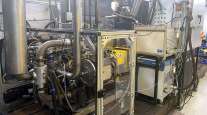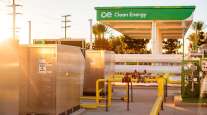Switching to Natural Gas Brings Maintenance Challenges
ARLINGTON, Va. — Trucking companies that move to natural gas use in their fleets will have to choose engine and fuel types, modify their maintenance shops and possibly install new types of equipment, all of which will involve higher spending, executives at American Trucking Associations’ Summit on Natural Gas in Trucking said.
Fleet managers intent on choosing natural gas as a truck fuel will have to go through a complicated and expensive process to convert — including numerous smaller choices and development of training and maintenance procedures, participants at the summit’s maintenance session said Friday.
Despite the intense level of work required, some carriers said they have found more natural gas use to be worthwhile.
“We’re trying to develop as many commercial configurations as possible,” said Scott Perry, vice president for supply management at Ryder System’s fleet management solutions unit, though he estimated the cost of outfitting maintenance shops to work on natural-gas vehicles would be $300,000 to $500,000 per shop.
Original equipment manufacturer Navistar Inc. developed a manual for its dealerships, telling them how to adapt their maintenance shops for natural gas. The starting point is that natural gas is lighter than air.
“If it escapes, it goes up and will collect in the top 18 inches below the ceiling,” said Nadine Haupt, director of alternative fuels for the truck and engine maker. “Take away all of the ignition points up there and put in methane detectors,” she said.
She said shop managers should remember that local building and fire codes are local ordinances and not federal laws, so they will have to deal with local fire marshals.
Michael Lickert, fleet manager of supermarket chain Giant Eagle, said one of the reasons his company prefers compressed natural gas is that it maintains the familiar odor caused by the insertion of mercaptan, while the intense cold of liquefied natural gas neutralizes the noxious smell.
As for costs, “you can go crazy on diesel-gallon equivalents and gasoline-gallon equivalents, so I just look at fuel costs per mile traveled — and it’s impressive,” he said.
Carriers wishing to build CNG or LNG fueling stations at their terminals will have to face more maintenance challenges, said Lilo Hurtado, an engineer with Exxon Mobil Corp.
“Failure to maintain filters and blow-down traps [in CNG dispensers can] potentially impact engine operation,” he said.
Ryder’s Perry agreed, saying that using poorly maintained fueling equipment will cause problems that could easily be avoided. As for LNG fueling, Ryder has produced a video on how to fuel with LNG that shows it to be a complex process.
Hurtado also advised that pure CNG or LNG engines operate at higher temperatures than conventional diesel engines and, therefore, need special oils.




